Key insights:
We doubt the reports indicating that Iran is exerting pressure on Hezbollah in order to prevent an escalation. It’s possible that this is another stage in Iran’s information warfare management, as well as an attempt to detach itself and misrepresent itself as a moderating element. According to our understanding, Iranian and Hezbollah intentions are to the contrary – to turn Israel into a war initiator and to seek regional escalation, thereby delegitimizing Israel. This interest, along with Hezbollah’s other long-term interests, was expressed about a year before the war commenced: Hezbollah’s repeated attempts to escalate the situation and “draw” Israel into a conflict (the border incidents, the Megiddo attack, rocket and anti-tank fire, the pitching of the tents at Har Dov, and so on).
Hezbollah is deeply concerned regarding the extent of Israeli intelligence penetration in particular, and Western intelligence penetration in general.
The Lebanese arena:
War data:
In Israel, the government evacuated 43 communities, for a total of about 61,000 citizens, located within five kilometers of the Lebanese border. To them were added several thousand more who decided to evacuate independently.
It is worth noting that several Israeli communities have not been completely evacuated, and there is still a civilian presence there. So far, Hezbollah has killed 5 Israeli civilians.
During the last week, Hezbollah claimed responsibility for 45 rocket attacks on Israeli territory, utilizing Grad rockets, Burkan heavy rockets, Falk-1 rockets, anti-tank missiles, and UAVs. Eight anti-tank, Grad, and Falk-1 rockets were launched against civilian areas including Kiryat Shmona, Safed, Yaron, Avivim, Even Menachem, and Shomera.
This week, Hezbollah launched heavy barrages on the cities of Kiryat Shmona and Safed. On February 13, Hezbollah fired anti-tank missiles on Kiryat Shmona. As a result, a child and a woman suffered serious injuries. On February 14, eleven rockets were launched toward the city of Safed and the Northern Command headquarters. One of the rockets hit the road leading to Safed Hospital. A second missile hit the Northern Command headquarters base, killing a female soldier and injuring eight others. Neither Hezbollah nor any other organization claimed responsibility for the incident. In response to Israel’s retaliation for the rocket firing on Safed, Hezbollah launched two successive barrages into Kiryat Shmona on February 15, including 11 Grad rockets and three anti-tank missiles in the first bombardment and several Falk-1 rockets in the second.
During the past week, Hezbollah announced that 18 of its operatives had been killed. It was also reported that 2 PIJ operatives and 5 Amal Movement operatives had been killed.
As of October 8, 2023, a total of 206 Hezbollah operatives had been killed. Most of the operatives killed lived south of the Litani River (130 of the operatives killed, constitute 63% of all the operatives killed). Many Hezbollah operatives and their families live in southern Lebanon, near the border with Israel. They operate in southern Lebanon as part of Hezbollah’s geographical units (Nasser and Aziz) and Hezbollah’s designated units (Radwan), while assimilating into the civilian population (human shield tactics).
According to Lebanese figures, so far, more than 270 housing units have been completely destroyed in southern Lebanon, and about 1,500 housing units have been partially destroyed.

Prominent airstrikes in Lebanon:
(February 14): Israeli retaliation to the rocket fire on Safed: Extensive airstrikes on Hezbollah targets in Nabatiyeh, Aadchit, Taiba, a-Souaneh, Jebchit, the area of Tafah, and more. There were over ten fatalities, including civilians who constituted human shields. On February 14, Hashem Safi al-Din, head of the Executive Council, said Hezbollah would respond with certainty at the required and appropriate level.
An airstrike on an apartment in a residential building in Nabatiyeh on the night of February 14 killed Ali Muhammad al-Debs, who was originally from the village of Blat and was presently residing in the town of Zebdine (the initial attempt to assassinate him on February 8 reportedly failed). Al-Debs’ jihadi nickname in Hezbollah was “Haidar.” Along with him, his deputy, Hassan Ibrahim Issa, from the town of Houmine el-Tahta, nicknamed “Karar,” was also killed. Another operative was killed along with them. Israel claimed responsibility for the strikes. According to the official publication, al-Debs was a central commander in the Radwan unit and was among those who planned the attack at the Megiddo junction (March 2023). As we published and assessed immediately after the Megiddo attack, we estimated that Hezbollah and Hamas were to be held responsible. In our understanding, the Palestinian terrorist (Hassan bin Jermi) from Burj al-Shamali (Tyre area), who carried out the Megiddo attack, was recruited and handled, in coordination with Hamas, by Hezbollah’s Unit 133 (1800). Hajj Khalil Harb is a very senior member of this unit and may have even returned as its commander. According to our assessment, al-Debs was responsible on behalf of the Radwan unit for the professional and committed training of the Palestinian terrorist who carried out the Megiddo incident. The training entailed, among other things, setting up and operating a roadside bomb.
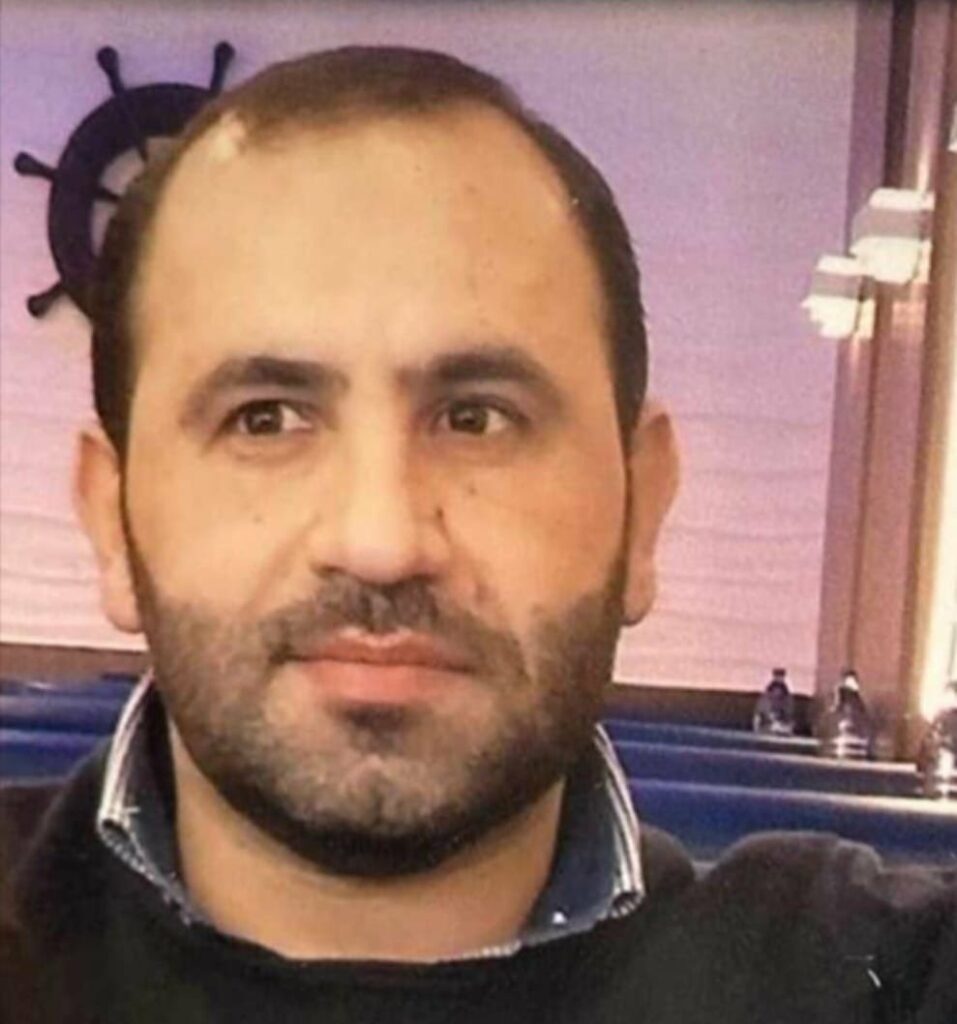
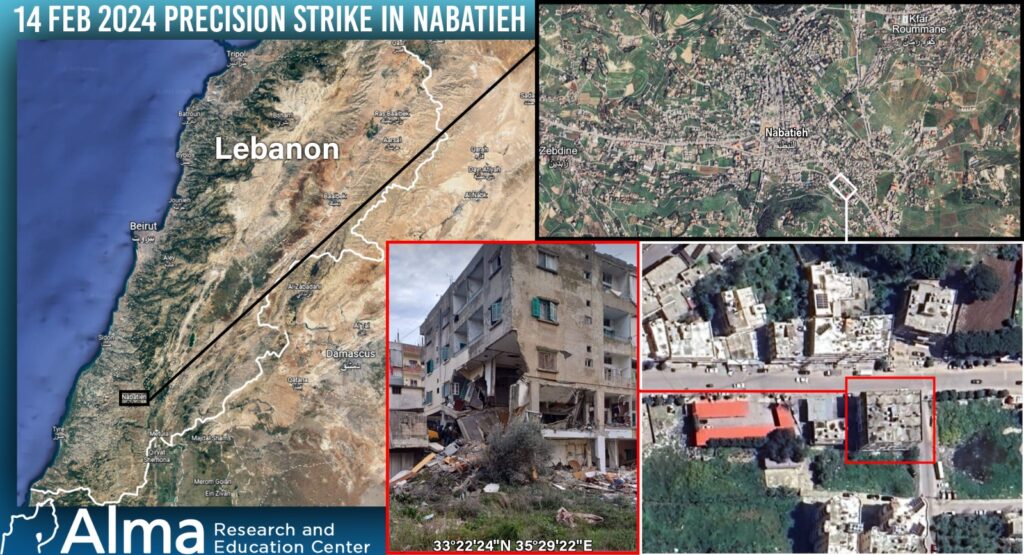
Hezbollah – General:
(February 13) The main points from Hassan Nasrallah’s speech on Injured Fighter Day:
Hezbollah will stop its attacks from Lebanon when Israel stops the fighting in the Gaza Strip. In light of this, the diplomatic initiatives at the moment are irrelevant, even if Hezbollah is offered proposals in its favor regarding the election of the Lebanese president. According to Nasrallah, “Western visits to Lebanon have a single goal, and that is to defend Israel and return its population to the north… Western delegations do not refer in their documents to anything related to the aggression and crimes taking place in Gaza.”
Hezbollah launched a confrontation with Israel in order to prevent it from winning in the Gaza Strip, and this is in the Lebanese national interest.
Israel is weak. Israel is not in a position to set conditions.
It can be seen that Nasrallah does not miss any opportunity to disseminate the narrative that “the resistance wins and Israel is defeated…”: “130 days of legendary steadfastness of the resistance fighters in Gaza, heroism that reaches a miraculous point and patience unparalleled in history, and 130 days of Israeli failure and inability to achieve goals”… 129 days of support and solidarity from the countries of the resistance axis and many peoples around the world… The front in southern Lebanon is one of pressure, support, and participation in defeating and weakening Israel until it reaches the point where it is convinced that it must stop its aggression on Gaza.”
1701 will not be accepted as it is, and Lebanon must set additional conditions in its context.
The residents of northern Israel who left their communities will not return to them at all if Israel continues to threaten: “There will be two million displaced people from the north, not a hundred thousand…”
Nasrallah warned against Israeli intelligence infiltration, with an emphasis on conduct through the Internet and cellular devices. Israel is assisted by them. There is a necessity to disconnect cameras connected to the Internet and stop using cellular devices.
It should be noted that Hezbollah is very concerned about the intelligence infiltration into its ranks, and Nasrallah’s statements on the matter are part of Hezbollah’s extensive campaign, directed mainly at residents of southern Lebanon.
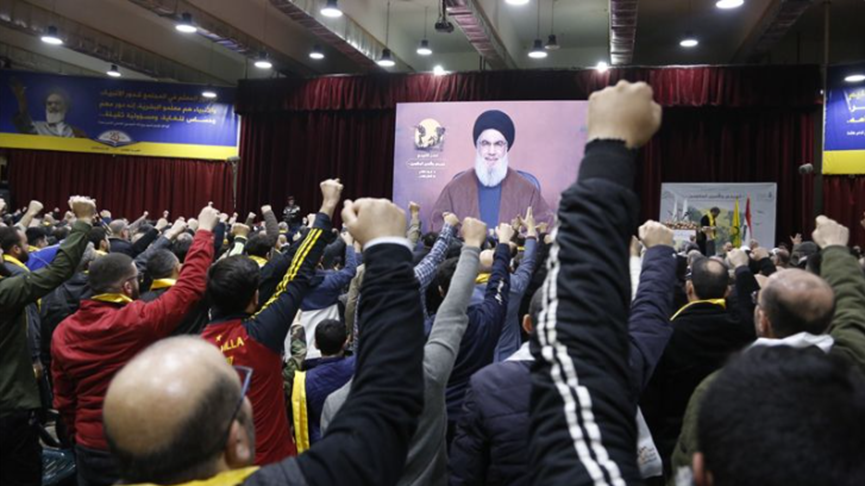
(February 16) Another speech by Nasrallah in memory of the “shaheed commanders” (Ghab Harb, Abbas al-Musawi, and Imad Mughniyeh): In the speech, Nasrallah particularly emphasized the equation of Hezbollah’s response to the killing of civilians following the IDF attacks on February 14, in which civilians were injured in Nabatiyeh and Souaneh:
“The price of the blood of civilians [Lebanese injured in IDF attacks] will be in blood, and not by attacking [in response] Israeli sites, mechanisms, and means of espionage… The enemy must understand that it has gone too far in this matter. The answer to this must be the continuation and escalation of work on the front… The attack on the settlement of Kiryat Shmona with dozens of Katyusha rockets and a number of Falk rockets “is an initial response” to what happened in Nabatieh and a-Souaneh. This front will not stop no matter how much [Israel] attacks, kills, and threatens… The resistance in Lebanon has tremendous rocket capability that can reach from Kiryat Shmona to Eilat.”
Hezbollah’s activity for the population:
(February 12) Hezbollah’s Islamic Health Organization and the Iranian physicians’ association “Giving Without Borders,” in cooperation with the labor committees in the camps, organized a special free health day in the camps in the Sidon region to mark the 45th anniversary of the victory of the Islamic Revolution in Iran and in memory of the “shaheed commanders.”
(February 14) Supply of generators in the Bekaa Valley and the central sector to ensure water supply to the towns of Beit Shama, Al-‘Aqidiyah, and Haouch al-Rafiqa.
(February 17) As part of the anniversary commemorating the “shaheed commanders” and the victory of the Islamic Revolution, a ceremony was held to dedicate a statue commemorating Imam Khomeini and Imam Khamenei in the courtyard of the Al Sayyida Maryam Mosque in the town of Haouch Barada in the Bekaa Valley, in the presence of Haj Hassan Hamia, head of Hezbollah’s “third zone”.
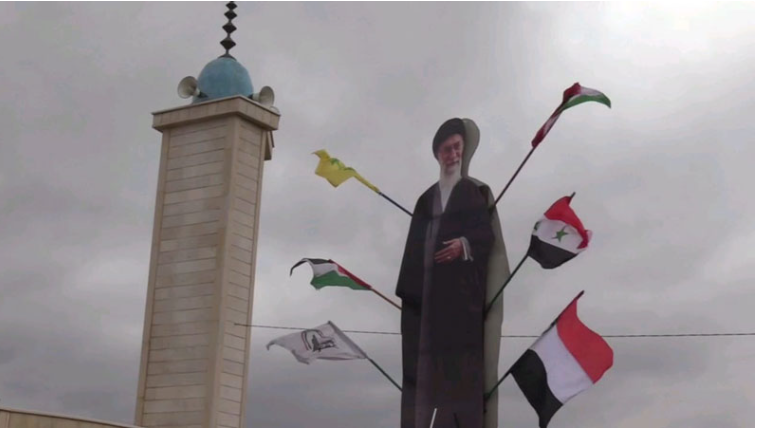
Lebanon – General:
February 14 The annual memorial for the death of Rafiq Hariri, former Lebanese prime minister, who was assassinated by Hezbollah with a truck bomb in 2005. The memorial service was attended and addressed by his son, former Lebanese Prime Minister Saad Hariri.
Will Hariri Jr. return to Lebanon and Lebanese politics? We’re not sure…
(February 16) UN survey on water infrastructure in Lebanon (according to a recent survey published by the UN Office for the Coordination of Humanitarian Affairs (OCHA) in Lebanon): In Beirut, 90% of the population drinks bottled water. In southern Lebanon, the figure stands at 67%. Less than a third of Lebanese have access to drinking water from the public network. 5% use “protected wells,” and 56% find it difficult to secure enough water for one of their various daily needs – drinking, cooking, or personal and household hygiene. The most prominent area with a water accessibility problem is the periphery: 50% of respondents in the Akar area and 35% in Baalbek-Harmel indicated that they suffer from a water crisis.
The Syrian Arena:
Airstrikes:
(February 12) According to Russian reports, an airstrike was carried out on the Nayreb airbase in Aleppo in the late morning hours, wounding three airport employees. There is no further verification of the attack. According to local reports, the explosions heard and seen in the area of the Aleppo airport did not originate from an attack but from controlled explosions carried out by the forces of the Syrian army’s engineering corps of old ammunition remnants of the civil war.
The Aleppo airport and its environs are a recognized geographical anchor for the activity of the Iranian arms corridor to Syria. The Aleppo area itself is a geographical anchor for the establishment of the Shiite axis in Syria.
(February 17) An attack was launched against a Syrian Army weapons depot in the area of the town of Mhajjah, north of the city of Deraa, after several rockets were fired from Syrian territory into Israeli territory in the southern Golan Heights. The rockets fell into Syrian territory. An unverified report claimed that the morning after the Israeli attack, five Russian military vehicles arrived at the site from Damascus.
If the report is correct, this is yet another indication of the Russian inclination toward restoring their involvement in the region.
Syria – General:
(February 12) The United Nations World Food Program (WFP) announced plans to resume aid in Syria in 2024 after ending it in December 2023 due to funding problems and to distribute $1 billion worth of food during the year. It should be noted that according to findings that we published in the past (December 2020) in southern Syria, Deraa Province, and in eastern Syria, Albukamal, the representatives of the UN Food Program work with contacts who are actually collaborators of the Shiite Axis, so that de facto those who prioritize food distribution are the Iranians and their proxies…
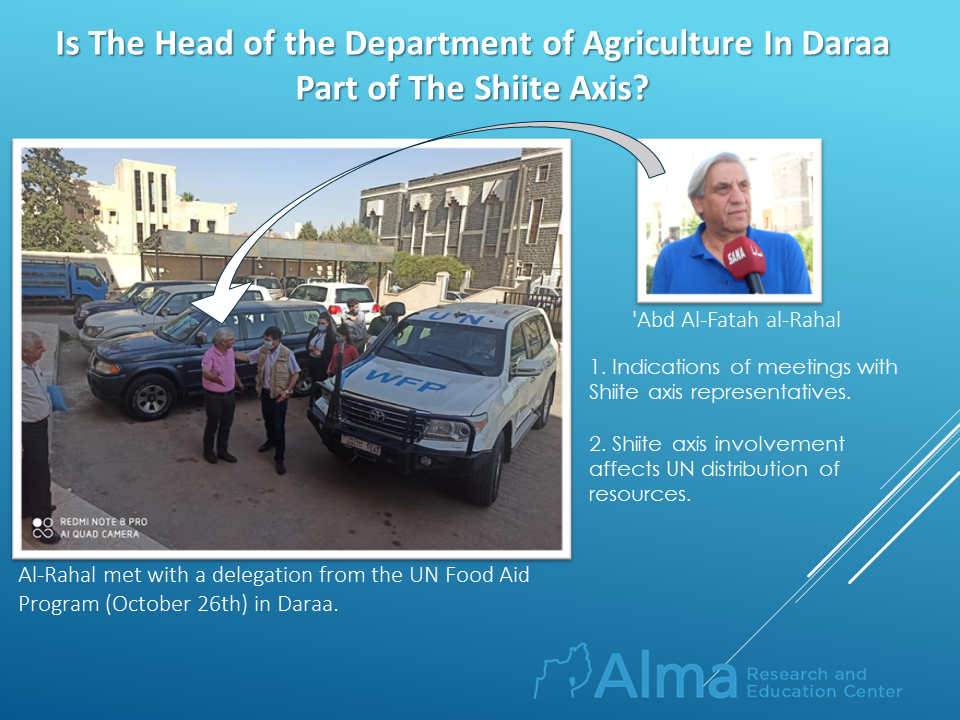
On February 18, a meeting of interior ministers against narcotics was held in Amman, Jordan, in the presence of the interior ministers of Jordan, Syria, Iraq, and Lebanon. The concluding statement stated that the four recognized the existence of a serious drug problem and agreed to cooperate in the fight against it while exchanging information and capabilities between the countries. That same day, the Jordanian army killed five Syrian drug smugglers while thwarting a major drug smuggling operation.
The Syrian interior minister represents a regime that is self-involved and encourages the Captagon drug manufacturing and smuggling industry. The Lebanese interior minister has no influence on the main element in Lebanon—Hezbollah—responsible for manufacturing and smuggling drugs.
We recommend that the Jordanian authorities rely only on themselves and continue to act independently and offensively on the issue without relying on promises or carrying out any Syrian and Lebanese operations.
Shiite Axis – General:
As of this writing, during the past week, only two rocket attacks have been carried out against US bases in eastern Syria. This compares with 6 attacks in the previous week:
(February 12) Shiite militias attack on the American base in Al-Omar.
(February 13) Shiite militias attack on the American base at the CONOCO gas field.
During the week, it was reported that Quds Force commander Ismail Qaani “managed to convince” the militias in Iraq not to attack American bases. We do not know how to assess the reliability of this report. The Iranians do not “convince” the Shiite militias. The Iranians give orders to the Shiite militias.
It is possible that this is another item that is part of Iran’s information warfare and an attempt by the Iranians to detach themselves from the attacks against the Americans. In practice, there was indeed a decrease in the number of attacks against the Americans. However, in our understanding, the trend should be tested over a period of time of more than one week. This may be an Iranian risk management and diversification tactic.
Houthi-Land:
During the past week, coalition forces, for the first time, managed to strike an unmanned submarine. They also struck 2 explosive boats, 3 UAVs, and 12 missiles launched or intended for launch by the Houthis.
(February 12) The Houthis report that they fired missiles in the early morning hours at the bulk cargo ship STRAR IRIS, sailing under the Marshall Islands flag. According to the ship’s radar, the ship was actually on its way to Iran…
(February 15) An anti-ship ballistic missile was launched into the Gulf of Aden at the British-owned merchant ship MV Lycavitos, sailing under the Barbados flag. There were no casualties, but the ship sustained minor damage.
On February 17, 4 anti-ship ballistic missiles were launched. The missiles were aimed at the Danish-owned ship MT POLLUX, sailing under the Panama flag. There were no casualties or damage.
At the end of January, the Americans seized a ship carrying weapons from Iran to the Houthis in Yemen. The ship contained: medium-range ballistic missiles, UAVs, unmanned vessels, anti-tank missiles, and optical equipment.
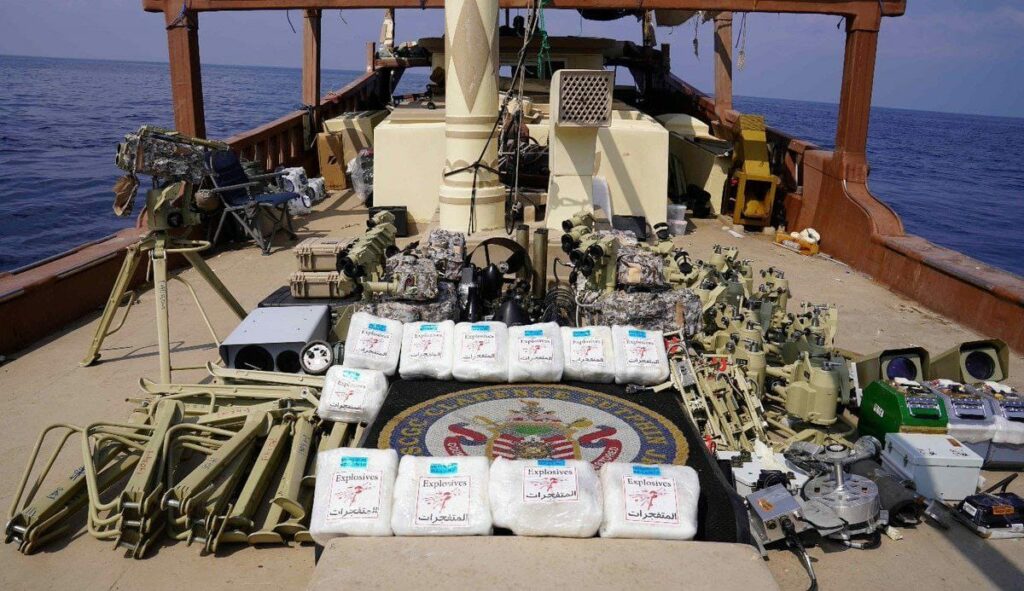

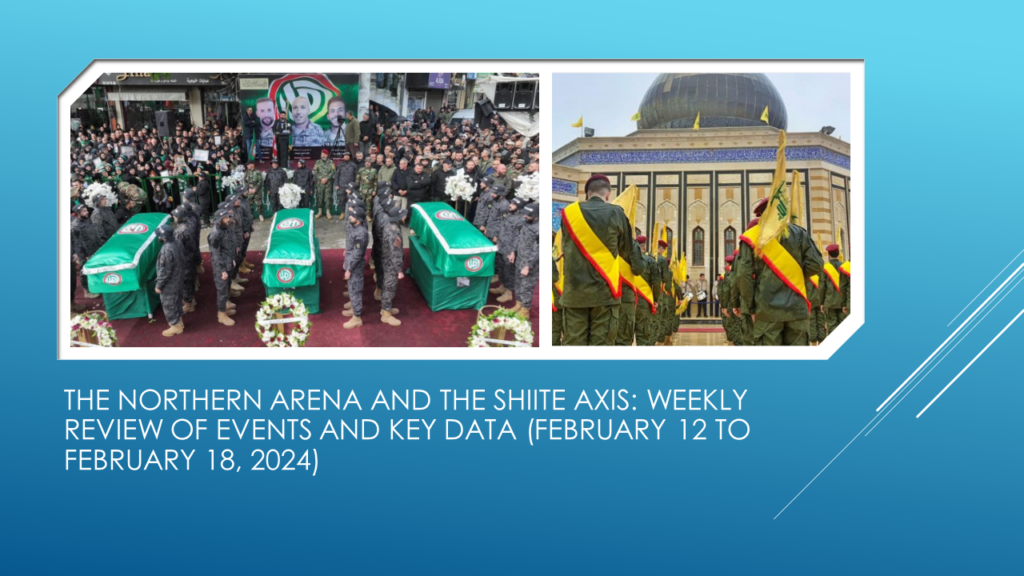





One Response
Considering the water shortages in Lebanon, water could be Hezbollah’s Achilles heel. Hezbollah’s underground facilities, networks and bunkers will require large amounts of water to sustain their operational capabilities. Where is the water coming from and where is it going ?